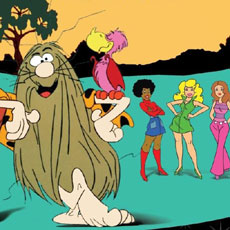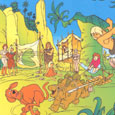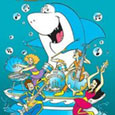Hanna-Barbera (1968), Warner Home Video (October 26, 2004), 3 discs, 408 mins plus supplements, 1.33:1 original full frame ratio, Dolby Digital Mono, Not Rated, Retail: $34.98
Storyboard:
A wacky group of drivers, using an oddball variety of souped-up autos and other incredible machines, compete in a race across the country.
The Sweatbox Review:
Hanna-Barbera had tasted great success in the mid/late1960s with their superhero and fantasy-adventure shows; but a backlash against cartoon violence initiated by parents’ groups saw these shows fall out of favor with network executives. Fortunately, Hanna-Barbera was developing a show that took a more comedic approach to action, and 1968 saw the debut of Wacky Races. The show was likely inspired by the 1965 Blake Edwards film The Great Race, but with even crazier characters and events. This was a large turnaround from the plot-driven shows they had most recently been doing, but was also a throwback to the gag-oriented Tom And Jerry shorts of the 1950s. In fact, Wacky Races had only a single, simple plot: oddball drivers and their nutty vehicles were competing in a race in order to gain the title of “World’s Wackiest Racer”. That was both the premise and the plot for each individual story. The only things that varied between shows were the locations and the outcomes, but the show became a huge hit for CBS.
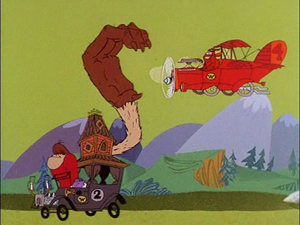
The simplicity of the show likely was part of its success, as viewers became caught up in trying to guess who would win each race, without the distraction of any significant plot complications. This might have gotten boring over time, but the other key to the appeal of Wacky Races was certainly its assortment of engaging characters and their wonderfully bizarre vehicles.
The driving team with the most screen time was the duo of Dick Dastardly and his snickering canine partner Muttley. They had a tremendously cool-looking car called the Mean Machine, but failed to win even a single time because they were always too busy trying to sabotage the other drivers. Added humor came from seeing how Muttley would almost seem to intentionally sabotage Dastardly, who would chastise Muttley repeatedly. Clearly, these two had a less than chummy relationship.

Aside from these two, there were: Peter Perfect in his sleek Turbo Terrific; lumberjack Rufus Roughcut and his beaver Sawtooth in the Buzzwagon (which ran on saw blades instead of wheels); Sergeant Blast and Private Meekly in the tank-like Army Surplus Special; seven-member gangster outfit the Anthill Mob in the Bulletproof Bomb; nutty professor Pat Pending and his Convert-a-Car; sweet beauty-conscious southern belle Penelope Pitstop and the Compact Pussycat; the hair-covered Slag Brothers (Rock and Gravel, who would communicate by grunts or by batting each other over the head with clubs) and their Boulder Mobile; the Gruesome Twosome and the Creepy Coupe (with a dragon along for the ride); the Red Max and his propeller-driven Crimson Haybailer; and a hillbilly named Luke and bear named Blubber in the Arkansas Chugabug. Together, these players made up the competitors in one of the zaniest shows on Saturday morning.
It is hard to imagine the show being nearly as much of a success without the superb design work of Iwao Takamoto and Jerry Eisenberg. This is especially true when one considers that the drawing on the show was often quite weak, at least in regards to the characters. After the elegant cartooning seen in The Flintstones, the drawing in Wacky Races appears clumsy and almost amateurish. (I wonder if this can be blamed on this being a co-production with Heatter-Quigley?) I’m sure that the storyboards for this show were usually funnier than the finished show itself because of this. Fortunately, there were some accomplished gagmen working on the show, such as Looney Tunes veteran Michael Maltese, and the humor of the gags managed to shine despite the questionable draftsmanship. The background artists did great work, though, using a number of different but pleasing styles.
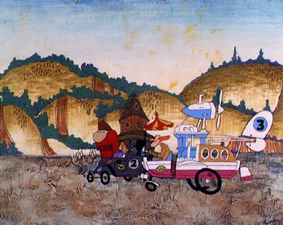
With so many characters in 10-minute stories, there was no real character development, but then this show was all about the gags anyways. Helping to sell the gags was the ever-present narrator, Dave Willock. It was his calling of the races that helped to unify the fairly plot-less storylines, as he commented on the constant scheming of Dick Dastardly, as well as the trials and tribulations of all the others as they streaked across the countryside. On the way, they would encounter snarling animals, bad weather, ghosts, and an assortment of natural and unnatural disasters. The show comes off as being pretty lightweight, but it is good fun. Just watching all the inspired characters and vehicles makes the show a goofy pleasure.
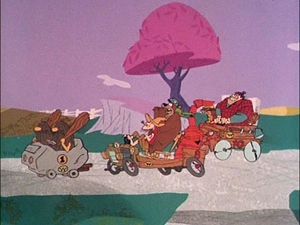
The show was so successful that it spawned two spin-offs the following year: Dastardly & Muttley In Their Flying Machines, and The Perils Of Penelope Pitstop. In my opinion, the spin-offs were actually superior shows, especially Penelope’s. Dastardly and Muttley would also later appear in altered form as The Dread Baron and Mumbly in 1977’s Scooby’s All-Star Laff-A-Lympics; their names and appearances were changed possibly due to the characters’ co-ownership with Heatter-Quigley (purely conjecture on my part). The Slag Brothers would turn up again in a way too, when their design was used for the basis of Captain Caveman.
Each of the 17 Wacky Races episodes had two stories, with zany titles like The Zippy Mississippi Race or Fast Track To Hackensack. On this DVD set, each story appears with a full opening and closing segment with credits, bringing the running time up to about 12 minutes. The three discs are single-sided and dual-layered, with fun artwork on each disc.

Is This Thing Loaded?
Warner Home Video has been getting better with putting worthwhile extras onto these Hanna-Barbera releases. After the anemic initial Flintstones and Scooby-Doo offerings, these sets have been getting much better.

Disc One’s Bonus Features menu lists none, but if you go to the Episodes menu, you will find two Selectable Onscreen Factoid subtitle tracks, featured on the first two stories. More than just subtitles, there is actual animation in these factoids, and their content is informative and entertaining. The second one even gives a final tally of how many times each driver placed first, second, and third in the series. (Proving that cheaters never prosper, The Mean Machine never placed once!) And speaking of the Episodes menu, each selection gives a different on-screen image from that particular show; this is one thing I really like about these H-B sets.
On to Disc Two, we have the featurette Rearview Mirror: A Look Back At Wacky Races (19:44). Cartoon historians Earl Kress and Scott Shaw! are joined by designers Iwao Takamoto and Jerry Eisenberg, voice artist Janet Waldo, and current cartoon creators like Paul Dini to dissect the show. It’s a grand little tribute to the show, even if it’s not truly all that in-depth.

Disc Three has another featurette, Spin-Out Spin-Offs (10:48), which basically serves as advertising for the later DVD releases of Dastardly & Muttley in Their Flying Machines, and The Perils of Penelope Pitstop. This is not a bad thing, though, as we get nice looks at both shows and how they differed from Wacky Races. (The material from this featurette, though, is repeated on the respective DVD sets for those shows). Then there are four Audio Commentaries on consecutive stories, featuring Takamoto, Eisenberg, Shaw!, and Kress. Takamoto and Eisenberg sound like two charmingly grumpy old friends who have difficulty recalling specifics while playfully chiding each other, but the commentary participants all do well to point out technical details (e.g. the use of five-field B.G.s) and animation mistakes. I especially appreciated the comments on how comedic considerations and the meager budgets for the show did not necessarily contradict the decision-making process; this is contrasted with today’s cartoons, which sometimes use visual tricks (especially with CGI) just because they can, at the expense of making a gag clear.
This last disc also has Sneak Peeks for other cartoon sets from Warner home Video.
Case Study:
Warner continues to shine with their packaging of these Hanna-Barbera sets. Once again, we have a terrific cel-type cover, with a colorful image superimposed onto a background that appears on the inner packaging. Take off the clear slipsleeve (which thankfully slides off so much easier this time around), and you see a different image on the digipack within. Every part of the digipack is full of colorful drawings of the cast, and there is a full listing of the disc contents as well.

This release unveiled the new title for the Hanna-Barbera Collection; no longer the “Hanna Barbera Golden Collection”, it became the “Hanna-Barbera Classic Collection” with this and subsequent releases. Why? No idea. There is also a prominent “1” on the spine for no apparent reason. After all, it’s the complete series. Why number the only volume? Both Jetsons and Jonny Quest had revivals in the 1980s (so they may yet get second DVD volumes), but Wacky Races didn’t. The number strategy would change with the Dastardly & Muttley, and Penelope Pitstop sets, incidentally. Is it too much to ask for a little common sense or at least consistency? Not really a big deal, though…
Ink And Paint:
Wacky Races is showing its age, with dirt, nicks and scratches that are easy to spot. The image is also very soft, nearly to the point of blurriness occasionally. I cannot say anything bad about the video compression, though. The image is perfectly stable, and no compression-related artifacts are seen. All in all, this is a pretty good presentation of an old, non-remastered show.

Scratch Tracks:
Warner Home Video correctly offers the original mono soundtrack, which is as good as it needs to be. Not surprisingly, this sounds very much like a show from 1968, perfectly fine but with little dynamic range. English, French and Spanish soundtracks and subtitles are available.

Audio-wise, the most enjoyable part of the show is the wonderful array of voice talent. Many Hanna-Barbera veterans (most or all with radio experience) lent their abilities to Wacky Races, including Daws Butler, Don Messick. John Stephenson, Janet Waldo, and Paul Winchell. To me, one of the great joys of watching Hanna-Barbera cartoons has always been to enjoy the terrific voices, and that is fully evident here. It almost is enough to distract one from the repetitive background music that plays constantly. (It’s OK an episode or two at a time, but gets annoying after sitting through a few in a row.)
Final Cut:
This was perhaps a strange choice of show at this stage in the Hanna-Barbera releases. It was popular at its time of airing, and has seen large popularity in Japan in recent years, but certainly cannot compare with the likes of Yogi Bear or Huckleberry Hound for name recognition. Perhaps the considerations of putting together those older shows made Wacky Races and its spin-offs more convenient choices. Personally, I would have preferred to have seen the 1960s shows Space Ghost And Dino Boy or Herculoids, but all in good time I suppose.
For now, we can enjoy this classic show. Weak drawing aside, Wacky Races is a typical example of the clean fun, strong gags, cool design, and superb voice work that could often be found in the Hanna-Barbera cartoons of the 1960s.
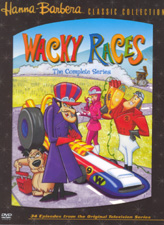 | ||
 |







